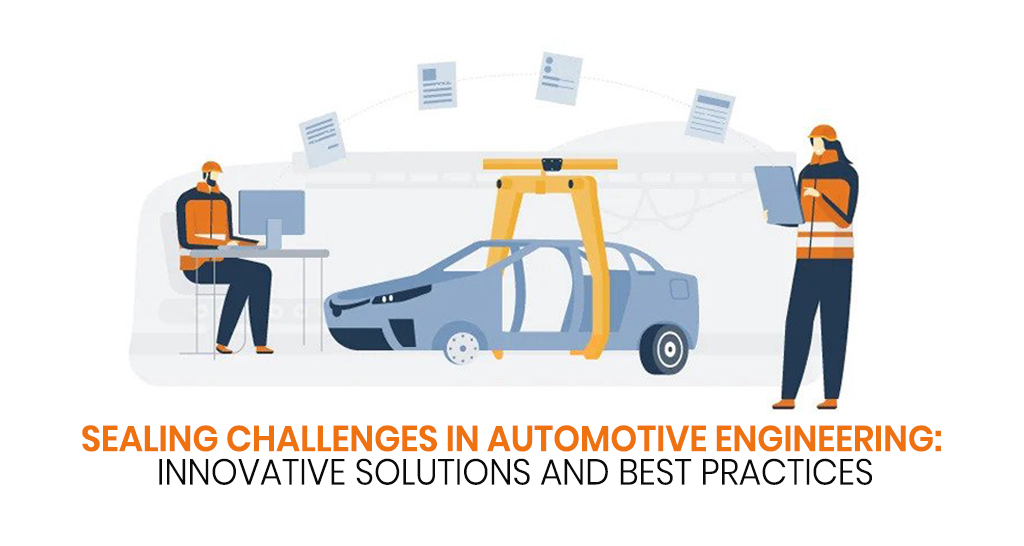One often underestimated yet critical aspect of automotive engineering is sealing. Sealing doesn’t stop with just preventing a few drops of oil from escaping; it’s also about creating a barrier that can withstand the extreme conditions these vehicle components are subjected to while on the road.
Proper sealing is an unsung hero that keeps vehicles on the road and passengers safe.
Below are common sealing challenges automotive engineers face and the innovative solutions and best practices to resolve these challenges.
Top 4 Sealing Challenges
1. Temperature Extremes
Vehicles experience a wide range of temperatures, from scorching summer days to freezing winter nights. Seals need to remain flexible and effective under these extremes, preventing leaks and maintaining optimal performance. And that’s why the Gore Universal Pipe Gasket has been an immense innovation in the world of automobiles. Being chemically resistant to all media pH 0-14 and a wide range of temperature and pressure cycles, this unique gasket is able to withstand the intense environments it’s subjected to without getting distorted.
2. Vibration and Movement
Cars are not stationary objects; they are constantly in motion, subject to vibrations and movements. Seals must withstand these dynamic forces while maintaining their integrity, as any failure can lead to oil or fluid leaks.
3. Chemical Exposure
Automobiles encounter a variety of chemicals, from motor oils to cleaning agents. Seals must resist degradation and remain chemically inert, ensuring long-lasting performance.
4. Wear and Tear
With the average lifespan of a vehicle extending over a decade, seals are expected to endure thousands of miles on the road. They must resist wear and tear, which is particularly challenging in high-friction areas.
The Role of Gasket in Resolving Sealing Challenges in the Automotive Industry
A gasket serves as a seal between two or more surfaces that come together, typically to stop any leaks from occurring when the objects are pressed against each other.
Gaskets are used as a sealing solution in car design. Without any doubt, the choice of gasket used has to be of outstanding properties to be able to resist wear and tear under various terrible conditions. Thankfully, the automotive industry has found reliable sealing in the form of the Gore® Universal Pipe Gasket (Style 800).
The Gore® Style 800 Gasket is a testament to advanced material science. Crafted from 100% expanded PTFE (ePTFE), it boasts properties that make it an ideal choice for the automotive industry. It exhibits low stress to seal, superior creep resistance, and high conformability to flange imperfections.
The versatility of the Gore® Style 800 Gasket is another point in its favor. It can withstand extreme temperatures, with an operating range from -450°F to +600°F. Pressure is no problem either, as it can be applied in pressures from full vacuum to +3000 psig, depending on the application and installation.
Incorporating this innovative sealing solution into automotive systems can address so many sealing challenges. As the automotive industry continues to seek better sealing solutions, the Gore® Style 800 Gasket serves as a prime example of how advanced materials and innovative design can revolutionize sealing in automotive engineering.
Innovative Solutions and Best Practices
Below are other solutions and best practices used that help address the common sealing challenges discussed:
1. Precision Engineering
Tolerances in modern engines and components are incredibly tight. Precision engineering is key to ensuring that seals fit seamlessly and maintain their integrity. Computer-aided design (CAD) and precision machining are crucial in this aspect.
2. Advanced Material Science
Thanks to advancements in material science, engineers now have access to cutting-edge materials like high-performance elastomers and expanded PTFE (ePTFE). Of course, the Gore Universal gasket is a testament to this. These materials can withstand extreme temperatures, resist chemicals, and provide exceptional sealing properties.
3. Innovative Seal Designs
Gaskets and seals are not one-size-fits-all. Innovative seal designs, such as custom shapes and composite structures, are developed to meet specific sealing challenges. These designs are tailored to the unique requirements of automotive applications.
4. Rigorous Testing
Before seals find their way into the engine or other vehicle components, they undergo rigorous testing. This includes evaluations of temperature resistance, durability under stress, and chemical compatibility. Only seals that pass these tests are deemed fit for automotive use.
5. Maintenance and Inspection
Regular maintenance and inspection are essential for ensuring seals continue to perform as intended. Implementing a maintenance schedule and replacing seals at recommended intervals can prevent unexpected failures.
Final Thoughts
The automotive industry’s relentless pursuit of better sealing solutions ensures that vehicles keep running smoothly, drivers stay safe, and our environment remains protected. As the automotive world continues to evolve, we can expect even more advancements in sealing technology.

